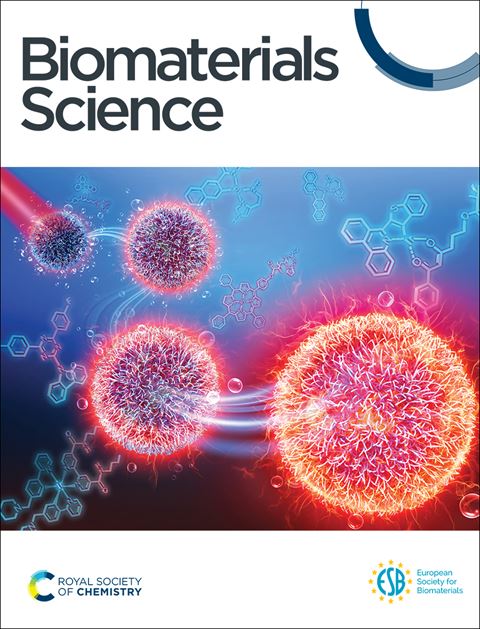氮化石墨碳作为一种新型抗癌剂:治疗前列腺癌和胶质母细胞瘤的潜在机制和疗效
IF 5.8
3区 医学
Q1 MATERIALS SCIENCE, BIOMATERIALS
引用次数: 0
摘要
碳衍生化合物因其独特的特性(如导电性和强度)以及在技术和医学领域的创新前景,正日益受到科学界的关注。氮化石墨碳(g-C3N4)因其在抗肿瘤疗法中的潜力而在这些化合物中脱颖而出。本研究旨在评估 g-C3N4 的抗肿瘤潜力和细胞毒性机制。前列腺癌(DU-145)和胶质母细胞瘤(U87)细胞系用于评估抗肿瘤效果,而 RAW 264.7 和 HFF-1 非肿瘤细胞用于评估选择性。利用 X 射线衍射、X 射线光电子能谱、扫描电子显微镜、能量色散 X 射线光谱、透射电子显微镜和原子力显微镜等多种技术对合成的 g-C3N4 颗粒进行了全面的表征,包括粒度、形态和氧含量的评估。结果表明,g-C3N4 显著影响肿瘤细胞的增殖和存活能力,在 48 小时内表现出较高的细胞毒性;在非肿瘤细胞中,除了对 RAW 264.7 细胞的细胞膜造成破坏外,对增殖的影响微乎其微。此外,g-CN4 改变了细胞形态和超微结构,影响了 U87 细胞的迁移,并有可能增强 RAW 264.7 细胞的迁移。在 Balb/C 小鼠体内进行的生化检测显示,丙氨酸氨基转移酶、天门冬氨酸氨基转移酶和淀粉酶水平发生了变化。总之,g-C3N4 具有良好的抗肿瘤效果,同时对非肿瘤细胞的毒性极小,这表明它具有治疗肿瘤的潜力。本文章由计算机程序翻译,如有差异,请以英文原文为准。
Graphitic Carbon Nitride as a Novel Anticancer Agent: Potential Mechanisms and Efficacy in Prostate Cancer and Glioblastoma Treatment
Carbon-derived compounds are gaining traction in the scientific community because of their unique properties, such as conductivity and strength, and promising innovations in technology and medicine. Graphitic nitride carbon (g-C3N4) stands out among these compounds because of its potential in antitumor therapies. This study aimed to assess g-C3N4's antitumor potential and cytotoxic mechanisms. Prostate cancer (DU-145) and glioblastoma (U87) cell lines were used to evaluate antitumor effects, whereas RAW 264.7 and HFF-1 non-tumor cells were used for selectivity evaluation. The synthesized g-C3N4 particles underwent comprehensive characterization, including the assessment of particle size, morphology, and oxygen content, employing various techniques, such as X-ray diffraction, X ray photoelectron spectroscopy, scanning electron microscopy, energy dispersive X-ray spectroscopy, transmission electron microscopy, and atomic force microscopy. The results indicated that g-C3N4 significantly affected tumor cell proliferation and viability, exhibiting high cytotoxicity within 48 h. In non-tumor cells, minimal effects on proliferation were observed, except for damage to the cell membranes of RAW 264.7 cells. Moreover, g-C3N4 changed the cell morphology and ultrastructure, affecting cell migration in U87 cells and potentially enhancing migration in RAW 264.7 cells. Biochemical assays in Balb/C mice revealed alterations in alanine aminotransferase, aspartate aminotransferase, and amylase levels. In conclusion, g-C3N4 demonstrated promising antitumor effects with minimal toxicity to non-tumor cells, suggesting its potential in neoplasm treatment.
求助全文
通过发布文献求助,成功后即可免费获取论文全文。
去求助
来源期刊

Biomaterials Science
MATERIALS SCIENCE, BIOMATERIALS-
CiteScore
11.50
自引率
4.50%
发文量
556
期刊介绍:
Biomaterials Science is an international high impact journal exploring the science of biomaterials and their translation towards clinical use. Its scope encompasses new concepts in biomaterials design, studies into the interaction of biomaterials with the body, and the use of materials to answer fundamental biological questions.
 求助内容:
求助内容: 应助结果提醒方式:
应助结果提醒方式:


